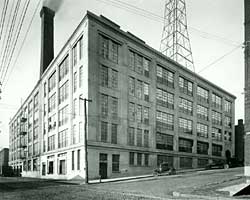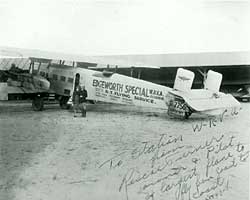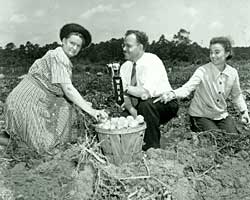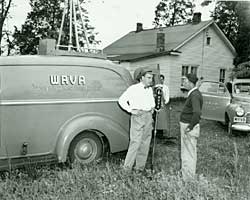From its first broadcast in 1925 from a studio in the Edgeworth
Tobacco factory in downtown Richmond to the multimillion dollar a year
business with new studios in Richmond's West End, WRVA has been the
"Voice of Virginia" for more than eight decades. Over the years, WRVA
has been blessed with excellent staff and announcers. Under the
management of Calvin T. Lucy, William R. Preston, and John B. Tansey,
WRVA grew from its modest beginnings in the Edgeworth Tobacco factory
to state-of-the-art studios on Church Hill.
|
| |
|
 |
 |
|
WRVA's first transmitting plant and
studio were located at the Edgeworth Smoking Tobacco Company, Main and
21st Streets. Over the years, the station increased its broadcasting
capabilities with larger and more powerful transmitters and towers. In
1968 WRVA moved into its new Church Hill studios designed by renowned
architect Philip Johnson. The Church Hill studios are now being
developed for other uses.
First Transmitting Plant. 1920s. Photograph. |
Publicity was crucial to building a
radio audience. In 1928, Roscoe Turner, a racing pilot and
barnstormer, advertised WRVA and its owner, Edgeworth Tobacco, and his
own flying service.
Roscoe Turner and his plane. 1928.
Photograph.
|
| |
At 9 P. M. on November 2, 1925, WRVA broadcast for the first time.
Owned by Larus & Brother Company, tobacco manufacturers, the station
initially operated as a community service without commercial revenue
and broadcast only two evenings a week. The third commercial radio
station in Virginia, WRVA quickly became the largest. The
thousand-watt transmitter Larus & Brother Company purchased from
Western Electric Company was only the fourth such transmitter
installed in the United States. WRVA became the most powerful radio
station operating between Washington, D. C., and Atlanta. Increasing
its broadcasting schedule and its power from 1,000 to 5,000 watts, by
1929 WRVA was broadcasting day and night seven days a week. That same
year WRVA became affiliated with the National Broadcasting Company
(NBC), an association that lasted until 1937 when WRVA joined the
Columbia Broadcasting System (CBS).
|
| |
|
 |
 |
|
Remote broadcast. 1940s.
Photograph |
Remote broadcast. 1940s.
Photograph |
| |
|
In May 1933, WRVA opened new broadcasting studios in the Hotel
Richmond, at 9th and Grace Streets. The new space included four
broadcasting studios, an announcer's booth, a control room, and office
space. Two years later, WRVA built a new 5,000-watt transmitter in
Mechanicsville. The tower was the first all-wood self-supporting radio
tower in North America. The station built a 50,000-watt transmitter
near Varina, in eastern Henrico County, in 1939 that dwarfed the power
of other radio stations in Virginia and allowed WRVA to increase the
number of its listeners, reaching audiences as far away as the west
coast, Canada, and even South Africa. In 1961, with much celebration,
the station installed a new 50,000-watt transmitter for WRVA-AM and a
200,000-watt transmitter for WRVA-FM.
In 1968, WRVA moved to a new studio designed by renowned architect
Philip Johnson. Overlooking downtown Richmond, the new location on
Church Hill symbolically represented WRVA's status as the Voice of
Virginia. The studio remained the home of WRVA until 2000 when the
station moved to the West End of Richmond.
The WRVA Radio
Collection at the Library of Virginia (pdf)
|
|
|
|